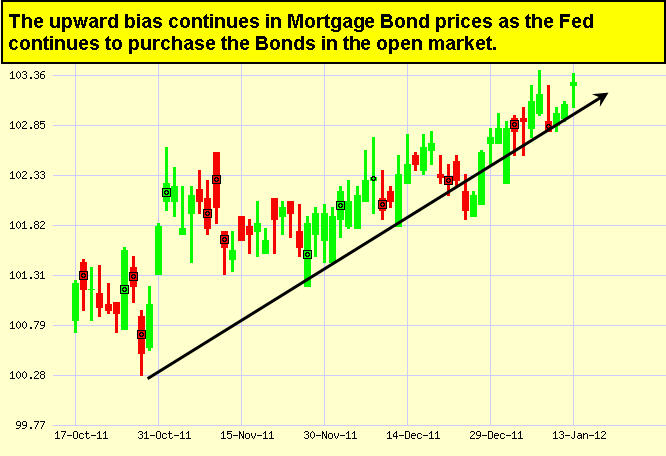In This Issue ![]()
| Last Week in Review:Consumers are feeling good, but how good was last week’s news?Forecast for the Week:It’s a holiday shortened week, but the economic calendar is full. News on manufacturing, inflation, and housing is ahead.View: Wondering what the housing trends for 2012 will be? Check out 11 trends we saw in 2011. |
| Last Week in Review |
|
“Happy days are here again.” Milton Ager and Jack Yellen. And while it seems that consumers are certainly feeling happier, not everything that happened last week was cause for song.
Retail Sales in December rose by a meager 0.1% from 0.4% in November, and when stripping out autos, sales actually fell 0.2%. Why did this happen? It seems that steep holiday discounting held down the value of goods sold, so sales were big, but only because of the heavy discounting. The news out of Europe last week also wasn’t too happy. German Chancellor Angela Merkel and International Monetary Fund Managing Director Christine Lagarde met to discuss and finalize the debt restructuring deal for Greece. Back in October, a deal called for Bondholders to “accept” a 50% haircut on the face value of the Greek debt – but as creditors and authorities have started to forge a final deal, the actual haircut back to investors is looking quite likely to be larger than 50%. This is simply because worsening financial conditions in the Greek economy make paying the debt back with “just” a 50% haircut highly unlikely…maybe impossible. What’s more, the next reasonable question to consider is will Ireland, Portugal and even Italy ask for a similar haircut or deal on what may be unsustainable debt in their countries? The happy news is that these problems are finally being addressed to make things better in the future. And in the short term, the uncertainty should keep money flowing into the relative safe haven of the US Dollar and US Bonds – including Mortgage Bonds, to which home loan rates are tied. In addition, Mortgage Bonds continue to be supported by the Fed’s purchases, which are also helping to keep home loan rates at record low levels. All of this means that now continues to remain a great time to purchase or refinance a home. Let me know if I can answer any questions at all for you or your clients. |
| Forecast for the Week |
|
Despite the Bond Markets and all Capital Markets being closed on Monday in observance of Martin Luther King, Jr. Day, the rest of the week’s economic calendar is full:
Remember: Weak economic news normally causes money to flow out of Stocks and into Bonds, helping Bonds and home loan rates improve, while strong economic news normally has the opposite result. As you can see in the chart below, Bonds and home loan rates are continuing their improving trend. I’ll be watching this closely as we head further into the new year. Chart: Fannie Mae 3.5% Mortgage Bond (Friday Jan 13, 2012)
 |
| The Mortgage Market Guide View… |
|
Housing News: 11 Trends from 2011
The National Association of Realtors® surveys homebuyers and sellers each year to uncover housing trends and monitor changes taking place in the industry. This year’s report highlights a number of trends that haven’t been seen in years. Here are just 11 highlights from the 2011 report. 1. In 2011, 37% of homebuyers were first-time buyers – which was down from 50% in 2010. 2. Last year, 88% of homebuyers used the Internet to search for a home. That number was down slightly from a high of 90% in 2009. 3. The typical homebuyer searched for 12 weeks and viewed 12 homes. 4. The number of buyers who purchased their home through a real estate agent or broker climbed to 89% – a share that has steadily increased from 69% in 2001. 5. Nearly 1 out of 4 buyers said the application and approval process was “somewhat more difficult” than expected…and 16% reported it was “much more difficult” than expected. 6. About half of home sellers traded up to a larger and more expensive home…and 60% traded up to a new home. 7. The top 3 factors influencing neighborhood choice were: the quality of the neighborhood, the convenience to job, and the overall affordability of homes. 8. The typical seller lived in their home for 9 years. That number has increased from 6 years in 2007. 9. Although 61% of sellers said they reduced their asking price at least once, the average home sold for 95% of the listing price. 10. Only 10% of sellers sold their homes without the assistance of a real estate agent. Of those people, 40% knew the buyer prior to the sale. 11. The typical “for sale by owner” home sold for $150,000 compared to $215,000 for the average agent-assisted home sale. All Contents ©2012 The National Association of Realtors®. Economic Calendar for the Week of January 16 – January 20
|
|
The material contained in this newsletter is provided by a third party to real estate, financial services and other professionals only for their use and the use of their clients. The material provided is for informational and educational purposes only and should not be construed as investment and/or mortgage advice. Although the material is deemed to be accurate and reliable, we do not make any representations as to its accuracy or completeness and as a result, there is no guarantee it is without errors.
As your mortgage professional, I am sending you the MMG WEEKLY because I am committed to keeping you updated on the economic events that impact interest rates and how they may affect you.
In the unlikely event that you no longer wish to receive these valuable market update
|


 There was good news last Friday, as the first look at Consumer Sentiment for January came in at 74.0, which is the highest level since May 2011. However, there was also news last week that the holiday shopping season may not have been as robust as previously thought.
There was good news last Friday, as the first look at Consumer Sentiment for January came in at 74.0, which is the highest level since May 2011. However, there was also news last week that the holiday shopping season may not have been as robust as previously thought.
